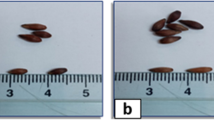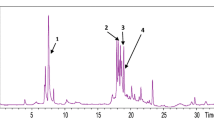Abstract
Considering the large consumption of Afrostyrax Lepidophyllus seeds, chemical analyses is necessary to ascertain its use as food spice and also its medicinal potential. Inductively coupled plasma mass spectrometry and gas chromatography mass spectrometry were used to evaluate the mineral and volatile contents respectively while column chromatography enabled the isolation of some compounds. Seventeen compounds were identified by gas chromatography mass spectrometry. Amongst detected sulphur containing compounds, methylsulfinyl(methylthio) methane was in highest amount with percentage composition of 12.25%. Fatty acids and their methyl esters were most abundant constituents notably n-hexadecanoic acid (28.86%) and methyl (E)-9-octadecenoate (21.85%). Some important unsaturated fatty acids notably linoleic acid and oleic acid were identified. Major elements detected in the sample were sodium (42,137.57 ppb), magnesium (456.90 ppb), phosphorus (1703.31 ppb), potassium (4948.88 ppb) and calcium (88.37 ppb. Trace elements detected in the sample are Cr (0.81 ppb), Mn (5.66 ppb), Fe (107.08 ppb), Co (0.14 ppb), Ni (6.77 ppb), Cu (50.05 ppb), Zn (32.06 ppb) and B (6.65 ppb). Other detected elements involved Al (42.25 ppb) and Pb (2.63 ppb) while Cd and Hg were below detectable limits. Five compounds were isolated and identified from their NMR spectral data as tripalmitin (AL23), n-hexadecanoic acid (AL40-45), ursolic acid (AL65), stigmasterol glycoside (AL192) and saccharose (AS329). Ursolic acid showed moderate ROS inhibition with IC50 = 18.5 ± 3.1 µg/mL compared to 11.2 ± 1.9 µg/mL for ibuprofen. NO inhibition and cytotoxicity on NIH-3T3 cell lines were low for tested compounds. This study fills knowledge gap on chemical analyses of A. lepidophyllus.





Similar content being viewed by others
Availability of Data
Data obtained and used in this study are available and can be obtained from the corresponding author upon request.
Abbreviations
- DCM:
-
Dicholoromethane
- EIMS:
-
Electronic impact mass spectrometry
- HREIMS:
-
High resolution electronic impact mass spectrometry
- MTT:
-
3-(4,5-Dimethylthiazol-2-yl)-2,5-diphenyltetrazolium bromide
- GC-FID:
-
Gas chromatography flame ionization detector
- GC–MS:
-
Gas chromatography mass spectrometry
- NO:
-
Nitric oxide
- ROS:
-
Reaction oxygen species
- ICP-MS:
-
Inductively coupled plasma mass spectrometry
- ppb:
-
Parts per billion
References
Moukette BM, Constant AP, Prosper CNB, Vicky JAM, Eustace B, Jeanne YN (2015) Afrostyrax lepidophyllus extracts exhibit in vitro free radical scavenging, antioxidant potential and protective properties against liver enzymes ion mediated oxidative damage. BMC Res Notes. https://doi.org/10.1186/s13104-015-1304-8
Namkona AF, Bolevane OSF, Moustapha F, Worowounga X, Ngaissona P, Koane JN, Syssa-Magalé JL (2017) Biological activities and phytochemical analysis of extracts Afrostyrax lepidophyllus Mildbr. seeds. J Phytopharmacol 6(2):102–106
Fogang HP, Maggi F, Tapondjou LA, Womeni HM, Papa F, Quassinti L, Bramucci M, Vitalis LA, Petrelli D, Lupidi G, Vittori S, Barboni L (2014) In vitro biological activities of seed essential oils from the Cameroonian spices Afrostyrax lepidophyllus MILDBR and Scorodophloeus zenkeri HARMS rich in sulfur-containing compounds. Chem Biodivers 11:161–169
Tchoupang EN, Ateba SB, Zingue S, Zehl M, Krenn L, Njamen D (2016) Estrogenic properties of spices of the traditional Cameroonian dish “Nkui” in ovariectomized Wistar rats. J Complement Integr Med 13(2):151–162
Ene-Obong H, Onuoha NO, Mbah O, Aburime L (2018) Chemical composition and antioxidant activities of some indigenous spices consumed in Nigeria. Food Chem 238:58–64
Onekutu A, Ugwu BF, Otakpa EO (2018) Toxicity of single and mixture application of Afrostyrax lepidophyllus and Afromomum melegueta seed powder on the biology of cowpea bruchid, Callosobruchus maculatus (F.). J Adv Biol Biotechnol. https://doi.org/10.9734/jabb/2018/39666
El-Seedi HR, Muhammad A, Nasr SK, Hanem HS, Shaden AMK, Khalijah A, Aamer S, Mohamed AF, Mohamed FA, Katinka P, Anna-Karin BK (2017) Essential oils of aromatic Egyptian plants repel nymphs of the tick Ixodes ricinus (Acari: Ixodidae). Exp Appl Acarol 73:139–157
Yirankinyuki FF, Wilson LD, Tatah VS, Aisha P (2017) Characterization and determination of antifugal activities of essential oil extracted from the bark of Afrostyrax lepidophyllus “Country Onion or Shirum”. Biochem Mol Biol 2(5):29–33
Ngane AN, Marie L, Seraphin D, Landreau A, Richomme P (2003) Three 1-thio-β-d-glucopyranosides from the seeds of Afrostyrax lepidophyllus Mildbr. Carbohydr Res 341(17):2799–2802
Belitz HD, Grosch W, Schieberle P (2009) Food chemistry, 4th revised and extended edn. Springer, Berlin, pp 421–428
Helfand S, Werkmeister J, Roader J (1982) Chemiluminescence response of human natural killer cells. The relationship between target cell binding, chemiluminescence and cytolysis. J Exp Med 156:492–505
Erharuyi O, Adhikari A, Falodun A, Jabeen A, Imad R, Ammad M, Choudhary MI, Gören N (2017) Cytotoxic, anti-inflammatory and leishmanicidal activities of diterpenes isolated from the roots of Caesalpinia pulcherrima. Planta Med 83:104–110
El Ashry SH, El-Tamany SH, Abd EFM, Aly MR, Boraei AT, Mesaik MA, Abdalla OM, Fatima B, Jabeen A, Shukrulla A, Soomro S (2013) Immunomodulatory properties of S- and N-alkylated 5-(1H-indol-2-yl)-1,3,4-oxadiazole-2(3H)-thione. J Enzyme Inhib Med Chem 28(1):105–112
Shah ZA, Jabeen A, Soomro S, Mesaik MA, Choudhary MI, Shaheen F (2015) Solid-phase total synthesis of cyclic peptide brachystemin A and its immunomodulating activity. Turk J Chem. https://doi.org/10.3906/kim-1412-58
Adebo O, Njobeh PB, Desobgo SCZ, Pieterse MKE, Ndinteh DT (2018) Profiling of volatile flavor compounds in nkui (a Cameroonian food) by solid phase extraction and 2D gas chromatography time of flight mass spectrometry (SPME-GC × GC-TOF-MS). Food Sci Nutr 6(8):2028–2035
Sharma KR, Agrawal M, Marshall MF (2009) Heavy metals in vegetable collected from production and market diets of a tropical urban area of India. Food Chem Toxicol 47:583–591
Łobinski R, Schaumlöffel D, Szpunar J (2006) Mass spectrometry in bioinorganic analytical chemistry. Mass Spectrom Rev 25:255–289
Nelms S (2005) Inductively coupled plasma mass spectrometry handbook. Blackwell Publishing Ltd, Oxford. ISBN 978-1-405-10916-1
Underwood EJ, Mertz W (1987) In: Mertz W (ed) Introduction in trace elements in human and animal nutrition, 5th edn. Academic Press, San Diego, pp 1–19
Bass JK, Chan GM (2006) Calcium nutrition and metabolism during infancy. Nutrition 22:1057–1066
Blair M, Wohlgemuth XW, Devendra B, Carolina A (2016) Genetic dissection of ICP-detected nutrient accumulation in the whole seed of common bean (Phaseolus vulgaris L.). Front Plant Sci 1:1. https://doi.org/10.3389/fpls.2016.00219
Martínez F, Uribe A, Milán R, Espinosa-García MT, García-Pérez C, Flores-Herrera O (2002) Differential effects of magnesium on the hydrolysis of ADP and ATP in human term placenta: effect of substrates and potassium. Int J Biochem Cell Biol 34:1004–1016
Jeejeebhoy K (2009) Zinc: an essential trace element for parenteral nutrition. Gastroenterology 137:S7–S12
Nielsen FH (2014) Update on human health effects of boron. J Trace Elem Med Biol 28:383–387
Gaetke LM, Chow CK (2003) Copper toxicity, oxidative stress, and antioxidant nutrients. Toxicology 189:147–163
Frossard E, Bucher M, Mächler F, Mozafar A, Hurrell R (2000) Potential for increasing the content and bioavailability of Fe, Zn and Ca in plants for human nutrition. J Sci Food Agric 80:861–879
Ajibola A, Chamunorwa JP, Erlwanger KH (2012) Nutraceutical values of natural honey and its contribution to human health and wealth. Nutr Metab 9:1–12
Harrison RM, Chirgawi MB (1989) The assessment of air and soil as contributors of some trace metal to vegetable plants. Sci Total Environ 83:13–34
Zugravu CA, Parvu M, Patrascu D, Stoian A (2009) Correlations between lead and cadmium pollution of honey and environmental heavy metal presence in two Romanian counties. Bull UASVM Agric 66:230–300
Acknowledgements
The authors are grateful to ICCBS and PCMD for assistance in analyses towards realization of this work.
Funding
This work was supported by TWAS Sandwich Fellowship (FR Number: 3240293193) offered to Dr. A. N. Tamfu.
Author information
Authors and Affiliations
Corresponding authors
Ethics declarations
Conflict of interest
The authors declare no competing interest.
Rights and permissions
About this article
Cite this article
Ngenge, T.A., Jabeen, A., Maurice, T.F. et al. Organic and Mineral Composition of Seeds of Afrostyrax lepidophyllus Mildbr. and Evaluation of ROS Inhibition and Cytotoxicity of Isolated Compounds. Chemistry Africa 2, 615–624 (2019). https://doi.org/10.1007/s42250-019-00087-6
Received:
Accepted:
Published:
Issue Date:
DOI: https://doi.org/10.1007/s42250-019-00087-6




